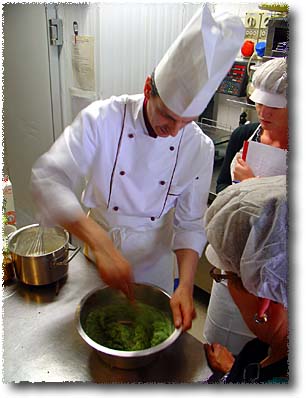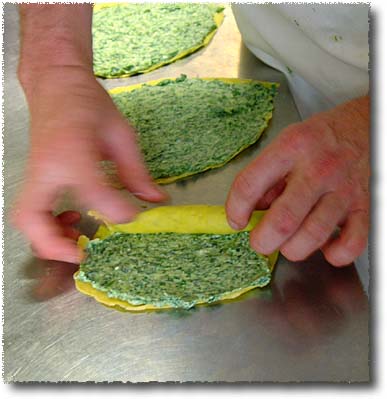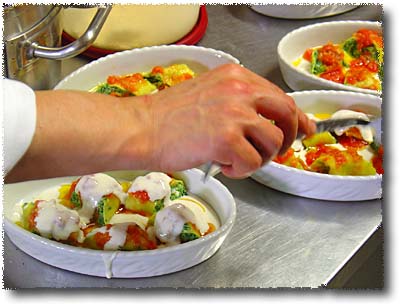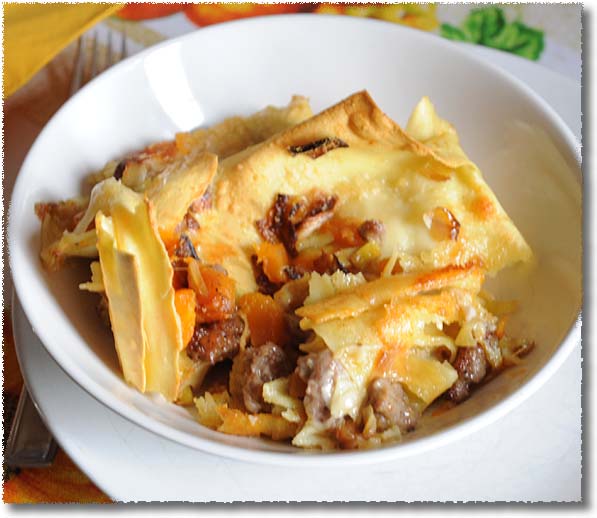Alessio’s Crespelle alla Fiorentina, An Illustrated Baked Pasta Recipe
Crespella is the Italian word for crepe, and they go back a very long ways. They also look beautiful, and are quite easy to make – once you have the hang of it – and are therefore the sort of thing that people will think you have gone to great deal more effort to make than you have. In short, the perfect beginning to a Sunday dinner or holiday meal, or something to serve company. Don’t let the length of the ingredients list scare you. Alessio Pesucci figures the below will serve 10, though you may find hearty eaters wanting seconds:
To Make 10 Crepes:
- 2 eggs, beaten
- 2/3 cup (80 g) white flour
- 1 1/2 tablespoons (20 g) clarified butter (one could use regular butter if need be)
- 3/5 cup (140 ml) milk, warmed to 100 F (40 C)
- A pinch of salt
- More clarified butter to grease the pan
For the Filling:
- 1 1/2 pounds (650 g) ricotta, ideally sheep’s milk, well drained
- 2 1/2 pounds (1.2 k) well-washed spinach
- 2-3 eggs
- 2/3 cup (30 g) freshly grated Parmigiano
- A pinch freshly ground nutmeg
- A pinch freshly ground pepper
- 1 teaspoon salt
For the Béchamel Sauce:
- 1 quart (1 liter) whole milk
- 1/3 cup plus 1 tablespoon (50 g) flour
- 1/4 cup unsalted butter
- 1/4 cup heavy cream
- 1 teaspoon salt
- A pinch freshly ground nutmeg
For the Tomato Sauce:
- 1 2/3 pounds (750 g) ripe tomatoes, blanched, peeled, seeded and chopped
- 1/4 cup olive oil
- A small onion, minced
- Minced celery equivalent to half the volume of the onion
- Minced carrot equivalent to a third the volume of the onion
- 6-7 fresh basil leaves, shredded
- 1/2 teaspoon salt
To Assemble It:
- 10 portion-size oven dishes
- 1 1/3 cups (75 g) freshly grated Parmigiano
- 1/4 cup unsalted butter
We’ll begin by preparing the crepes:
Whisk the eggs until they are yellow, adding a pinch of salt. Next, whisk some of the flour into the eggs (don’t worry about lumps at this stage), followed by some of the milk, more flour, and more milk until all is added; whisk until the batter is smooth and runs in a thin stream from the back of a spoon. From start to finish, mixing the batter will take about 3 minutes.
Heat a 12-inch diameter (30 cm) high-sided skillet with a non-stick surface over a fairly brisk flame until it is hot — a drop of water should dance upon it. Lightly grease it, remove it from the burner, and pour a small ladle of batter (a bit more than 1/4 cup) into it at a slant, turning the pan so the batter coats the bottom of the pan.
Return the pan to the burner and cook until the crepe firms up. Use a wooden spatula to loosen the crepe, and flip it to cook the other side.
In all, the cooking time will be about 2 minutes, and with a little practice you can learn to flip the crepes with a flick of the wrist after loosening them: Hold the pan at a slant, dip it (moving the pan forward and down), and then pull back with a deft upwards flick: the crepe will rise up and flip over.
Prrof? I watched Alessio prepare these for a cooking lesson, and though some of the students had their doubts about flipping crepes with a flick of the wrist, everyone did it. So it’s not difficult.
And next, the filling:
Wash the spinach well, and put it in a pot with the water that adheres to the leaves. Bring it to a boil and cook it for 2 minutes, by which time it will have wilted completely. Remove it from the pot, and as soon as it has cooled to the point that you can handle it, chop it finely.
Alessio prefers sheep’s milk ricotta because cow’s milk ricotta has a floury texture, but cow’s milk is what you have it will work well too.
Put the chopped spinach in a large bowl and mix the ricotta into it, together with the eggs, Parmigiano, nutmeg, pepper, and salt. Continue mixing until the filling is creamy and homogeneous.
As you make the crepes, lay them flat on your work surface. When you have finished making crepes (you should have about 10), put a dollop of stuffing on each and spread it out to a thickness of 1/8 of an inch (3 mm) or so.
Fold the left and right sides of the crespelle in to help keep the stuffing in place, and roll the crespelle up.
Put the crespelle in a pan for now, and see to making the béchamel sauce and the tomato sauce.
First, the tomato sauce:
Blanch, peel, seed, and chop the tomatoes. Chop the onion, carrot, and celery too. Heat the olive oil in a pot and add the chopped herbs and salt. Cook until the onion is translucent, add the tomatoes, and simmer. Add the shredded basil shortly before assembling everything.
Next, see to the Bechamel sauce:
Make a roux with butter and the flour, heating it until it is tan. Let it cool some while bringing the milk to a boil. Stir the hot milk into the flour mixture — the temperature difference will keep lumps from forming — and season the mixture with salt, pepper, and nutmeg. Simmer the béchamel sauce for 5 minutes, and then remove it from the fire. Stir in the cream, which contributes to the sauce’s texture, and spread a spoonful of béchamel over the bottom of each of the oven dishes.
Cut the crepes at a slant into sections about an inch and a half (3.5 cm) across, and divvy them evenly among the oven dishes. While you are doing this, preheat your oven to 400 F (200 C).
Sprinkle tomato sauce over the crepe sections, and spoon the remaining béchamel sauce over the tomato-coated crepes — it will keep the tomatoes from burning.
Dot the crepes with the remaining butter and sprinkle the grated cheese over them.
Dot the crepes with the remaining butter and sprinkle the grated cheese over them.
Bake the crespelle for 10-12 minutes, and serve them at once with an elegant white wine. I would be tempted by a good Vernaccia di San Gimignano along the lines of Montenidoli’s Vernaccia Fiore, or perhaps a Vermentino from the Colli di Luni.











